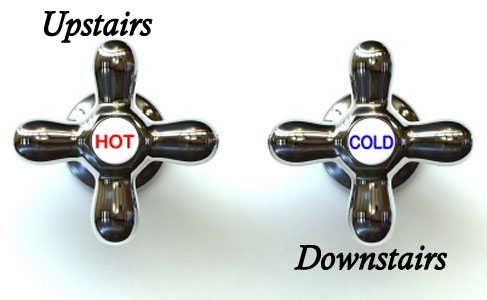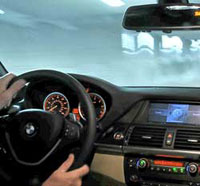Ever Wonder Why the Downstairs is Cold and the Upstairs is Hot?
We cannot change the physics of air movement so we have to work within the confines of those physics. In the winter when you are running your furnace, we need to take more cold air from the downstairs and move it to the warmer upstairs and push the hot air from the upstairs to the downstairs. |
|
In the summer cooling season when you are working your air conditioner, we need to take the cold air from the downstairs and move it to the upstairs while taking the hot air upstairs and pushing it into the cooler downstairs. |
|
You would think so on the surface, but in reality moving cold air upstairs in summer cooling season is very different from moving warm air in the heating season downstairs. These seem like the same problem, but in reality they are two different problems because of the supply air patterns and the return air patterns. |
|
Let’s take the winter time first and discover how to warm your entire home rather than just heating up the upstairs. |
|
Step #1: Remove the cold air downstairs and pull it into the heating process in your furnace. This means having a return register drawing air at the lowest part of the home. If you don’t have a return air pulling air from the lowest part of the home that air at ground level will be stagnant and cold. Cold air is heavier than warm air and it will not jump up and go upstairs all by itself. A large return air register and duct from the downstairs to the furnace blower compartment will suck that cold air up for the furnace to warm. |
|
Step#2: You have to have more airflow downstairs and it should be as low as possible. Registers down at floor level are best, but registers in the wall closer to the ceiling will work if the return air register is pulling that cold floor air into your forced air furnace. |
|
Step#3:
(This is a manual air damper that is usually located in the attic) |
|
Step#4:
Why a variable speed blower motor drive? The reason for a variable speed motor is that when it is operating in circulating mode (not controllable by an ordinary thermostat) the motor will only be drawing about 40 to 50 watts of electricity. That means that you will be paying about $5 a month in electricity to operate that blower. Very easy on the wallet for the benefits of both air cleaning and air balancing in your home. A regular blower motor drawing about 6 amps of electricity at 120volts will cost you about $60.00 a month to operate. Why not have the forced air furnace or air handler pay for itself in electricity savings each month? |
|
(American Standard 3 stage variable speed 95.5% AFUE furnace with a whole house air cleaner, Accuclean, installed) No one wants a cold home, especially me. That is why a minimum of two stage heating and preferably three stage heating, is better. If you have a large temperature swing on the thermostat, say 3 degrees or more, the furnace will turn on in full btu heating more (requires a special thermostat). This will heat the home up quickly when it is called for. Then the furnace will kick down to stage one heat which is roughly about ½ the number of btus (British thermal units. 1 btu is the amount of energy required to raise 1 pound of water one degree and one Ton, 12,000 btus is amount of energy required to melt one ton of ice). This lower output will allow the warm and cool air to circulate throughout the home enabling a more even temperature without the wild temperature swings and wild gas bills caused by a furnace cycling between full on and full off. Think of the gas you would use if every time you drove your car the throttle was required to wide open and then you had to turn it off and restart it at every stop light. That is what your normal minimum efficiency furnace, most likely the one you have in your home right now, is doing and doing up to 10 thousand times a year. |
|
|
We solved the winter cold downstairs problem so let see if we can solve the summer hot upstairs problem. You know the “so hot and sticky at night even with the air conditioning running weather that you can’t sleep” |
|
Step#1.
(Filter registers or grills are often installed when switching from a floor or wall furnace to a forced air heating and air conditioning system.) |
|
You have to have more airflow upstairs and it should be just above head level, no more than is necessary to distribute the cool air evenly. Registers down above the door level are best, but registers in the ceiling will work if they are the correct type for that application. There are many types and configurations of air register and not all of them work in every situation. (Supply and return temperature for air conditioning should be about 20 degrees apart.) |
|
Damper down the downstairs registers to lower the airflow downstairs and help to force the cooler, heavier air upstairs. You won’t need very much airflow downstairs because the cool air from the upstairs will cool the downstairs through the floors and through the stairwell. Install airflow dampeners in the ductwork as far away from the registers as possible. The farther away from the register those dampeners are located, the less noise the registers will make. If the registers are still making too much noise it is a sure sign that your registers and ductwork upstairs are not large enough to handle the proper airflow. Moving those air dampeners at least 10 feet away will most likely remove any appreciable noise from the registers. We are after comfort, not a rock and roll concert. (American Standard 20 SEER 2 stage air conditioner) |
|
Install a forced air furnace or air handler with a variable speed motor drive and a multi-stage air conditioning condenser. Since cold air isn’t going to stop falling just because you turn off your central air conditioning system you will need the blower motor continually moving air from the upstairs to the central air conditioning unit to maintain an even temperature in the home. Turn off the blower motor and the problem reoccurs. We cannot stop the physics of heat rise, we can only do battle with it. (American Standard high efficiency air handler with a whole house Accuclean air cleaner installed underneath) |
|
So we have quandary don’t we. It seems impossible to both be comfortable downstairs and upstairs in the summer cooling season and by comfortable downstairs and upstairs in winter heating season. That really isn’t true. If there is problem, there is an engineer waiting by to solve that problem. There are two ways to solve this problem. The first and best method is also the most expensive method (you were waiting for that weren’t you). This involves splitting the system up and placing the downstairs and upstairs on two completely different and unattached central heating and central air conditioning systems. That is great for homes in excess of about 3,000 square feet, but what about the rest of us. |
|
In a modern central heating system and central air conditioning system, we can install zone controls. Zone system thermostats are placed throughout the home. We can use 2, 3, 4 or more thermostats depending upon what areas are experiencing temperature and air flow problems. Each thermostat is considered a master thermostat as it can turn the central heating system on or it can turn on the central air conditioning system. The system is connected to the home’s furnace or air handler via a circuit board. The thermostats control the heating and cooling and control what automatic dampers turn and off and when. Installing a return air upstairs and a return air downstairs and then having the thermostats turn one on and other partially off during the heating season and just the opposite during the cooling season can really make a very significant difference in the comfort level of your home. (The picture is a Honeywell automatic air damper that is usually installed in the attic and control by a single room thermostat) |
|
A zoning system can allow you to have one temperature in one room and another temperature in another room. |
|
If you live here in Southern California you can give us a call and we can perform this work for you. If we cannot solve the heating and air conditioning problems that you are having, we will give you back your investment in full. We will even give you an entire year to think it over. This way you can test your new home comfort system through every season of the year. You can trust us, but you do not need to. Every single guarantee that I have been mentioning in this website is in writing in plain English on every agreement we enter. If we should change our mind and not give you back your money, it has never happened, we have a bond that you can apply for to receive back and avoid us altogether. We are that sure that you will pleased with our work. You are in charge. Give us a call at (877) 247-6426 and experience for yourself the level of comfort in your own home that you have been missing. Call now. |
|
We work on all furnaces and heaters including Rheem furnace, Ruud furnace, Carrier furnace, Day and Night furnace, Bryant furnace, Lennox furnace, Ducane furnace, Premier furnace, York furnace, Heil furnace, Tempstar furnace, Coleman furnace, Red t furnace, Cozy furnace, Empire furnace, Williams furnace, Interthem furnace, Trane furnace, American Standard furnace and more. Some of the cities that we work in are: Aliso Viejo, Anaheim, Brea, Buena Park, Costa Mesa, Cypress, Dana Point, El Toro, Fountain Valley, Fullerton, Garden Grove, Huntington Beach, Irvine, La Habra, La Palma, Laguna Beach, Laguna Hills, Laguna Niguel, Laguna Woods, Lake Forest, Los Alamitos, Mission Viejo, Newport Beach, Orange, Placentia, Rancho Santa Margarita, San Clemente, San Juan Capistrano, Santa Ana, Seal Beach, Stanton, Tustin, Trabuco Canyon, Villa Park, Westminster, Yorba Linda, Sunset Beach, Bell Gardens, Bellflower, Carson, Cerritos, Commerce, Diamond Bar, Downey, Gardena, Hawaiian Gardens, Industry, La Habra Heights, Lakewood, La Mirada, Long Beach, Lynwood, Montebello, Norwalk, Palos Verdes, Paramount, Pico Rivera, Rancho Palos Verdes, Santa Fe Springs, Signal Hill, South Gate, Whittier We specialize in heating repair, furnace repair, air conditioning repair, a/c repair, a c repair, duct repair, duct cleaning. We also install new air conditioning, new a/c systems, new furnaces, new heaters and new heating systems. We work on heat pumps, split air conditioning systems, water furnaces, hydronic heaters, package air conditioners and mini split ductless systems. Print this A/C checklist before you have a service technician come to your home |
|
You will be 100% Satisfied and I am betting my paycheck on it! |
We guarantee everything we do. |
Long term member in great standing. You can trust us with your home comfort needs. |
Recognized and approved as a member providing excellent services. |
"Because these young men did such a good job and I might say were very gentlemanly, I would recommend Empire to others for their heating and air conditioning needs." |
|
Nancy Henrick |
|
"Just a note to let you know how much we appreciate Brian, Neil and Keith for their friendly, courteous, professional and informative manner. We look forward in the future to call on Empire for our needs." |
|
Robert Pearson
|
|
"You demonstrated good character, very polite and informative. You also had good work habits (kept the place clean) with the ability to work with us as individuals and got it completed to our satisfaction." |
|
Hazel La Vigne |
|





 Okay, it’s a fairly easy question to answer.
Okay, it’s a fairly easy question to answer. Isn’t that exactly the same thing?
Isn’t that exactly the same thing?

 The reason why you need, or should have, a two or three stage central heating system
The reason why you need, or should have, a two or three stage central heating system Remove the hot air upstairs and pull it into the cooling process in your air conditioning system. This means having a return air register drawing air, not at the highest part, but at the highest inhabitable part of the home. We really do not care how hot the air is 3 feet or more above your head upstairs as nobody is in that area to be uncomfortable and need air conditioning. If you do not have a return air register pulling air from the highest habitable area of your home that air will become stagnant and remain uncomfortably warm if not downright hot. Hot air is heavier than cold air and it will not voluntarily walk down the stairs by itself. A large return air register and duct from the upstairs to the furnace blower compartment will draw the hot air into the air conditioning system to cool off.
Remove the hot air upstairs and pull it into the cooling process in your air conditioning system. This means having a return air register drawing air, not at the highest part, but at the highest inhabitable part of the home. We really do not care how hot the air is 3 feet or more above your head upstairs as nobody is in that area to be uncomfortable and need air conditioning. If you do not have a return air register pulling air from the highest habitable area of your home that air will become stagnant and remain uncomfortably warm if not downright hot. Hot air is heavier than cold air and it will not voluntarily walk down the stairs by itself. A large return air register and duct from the upstairs to the furnace blower compartment will draw the hot air into the air conditioning system to cool off. Step#2:
Step#2: Step#3:
Step#3:  Step#4:
Step#4: The solution for most people is to install a zoning system.
The solution for most people is to install a zoning system. So that is your 9 step process to as close to perfect heating and cooling as is possible.
So that is your 9 step process to as close to perfect heating and cooling as is possible.





 Your 365 Day Free Test Drive
Your 365 Day Free Test Drive Your No Lemon Firebox Guarantee
Your No Lemon Firebox Guarantee




